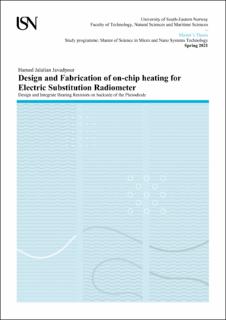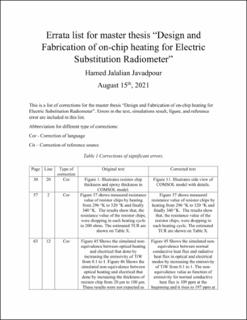| dc.contributor.advisor | Bardalen, Eivind | |
| dc.contributor.author | Jalalian Javadpour, Hamed | |
| dc.date.accessioned | 2021-09-25T16:12:27Z | |
| dc.date.available | 2021-09-25T16:12:27Z | |
| dc.date.issued | 2021 | |
| dc.identifier | no.usn:wiseflow:6046156:44921500 | |
| dc.identifier.uri | https://hdl.handle.net/11250/2782612 | |
| dc.description.abstract | This thesis describes the design, simulations, and fabrication of heating resistors by the
photolithography process, and finally integration of a selected resistor through a bonding
procedure to the backside of a photodiode. TiW (90/10%) is used for resistor lines and
Au is used for resistor pads. The fabricated resistors are integrated into an electric
substitution radiometer (ESR) equipped with a predictable quantum efficient detector
(PQED) to assemble a dual-mode detector module (DMD).
This research project is part of the European research project chipS·CALe [1], which is
in close collaboration with Justervesenet, Norway's metrology institute. The goal of this
research is to develop high-precision optical power measurement techniques using silicon
photodiodes.
After describing the process of the integration of the heating resistor onto the backside of
the photodiode, the assembly of the dual-mode detector module will be explained. This
is where a mix of wire bonding techniques and silver conductive epoxy were used to make
a connection between the bottom printed circuit board (PCB) and the top PCB (attached
to photodiode with resistor). | |
| dc.description.abstract | | |
| dc.language | eng | |
| dc.publisher | University of South-Eastern Norway | |
| dc.title | Design and Fabrication of on-chip heating for Electric Substitution Radiometer | |
| dc.type | Master thesis | |

